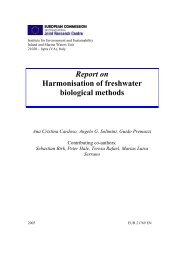Lakes and Watercourses
Lakes and Watercourses
Lakes and Watercourses
Create successful ePaper yourself
Turn your PDF publications into a flip-book with our unique Google optimized e-Paper software.
show the availability of nitrogen in relation to phosphorus in lakes.<br />
In class 1 the availability of phosphorus alone governs production; in<br />
class 2 there is a tendency for accumulation of cyanobacteria (”bluegreen<br />
algae”) in general; in class 3 the occurrence of nitrogen fixation <strong>and</strong><br />
specific nitrogen-fixing cyanobacteria is likely; in class 4 nitrogen fixation<br />
is highly likely but cannot fully compensate for the nitrogen deficit, <strong>and</strong><br />
in class 5 the nitrogen deficit is extreme <strong>and</strong> fixation is unable to<br />
compensate.<br />
TABLE 5.<br />
CURRENT CONDITIONS: area-specific loss of total nitrogen,<br />
watercourses (kg N/ha, year)<br />
Class Description Area-specific loss<br />
1 Very low losses ≤ 1.0<br />
2 Low losses 1.0 – 2.0<br />
3 Moderately high losses 2.0 – 4.0<br />
4 High losses 4.0 – 16.0<br />
5 Very high losses > 16<br />
Area-specific losses refer to the monitoring of concentrations 12 times<br />
a year over three years <strong>and</strong> recorded or modelled water flow per 24-hour<br />
period. It may be necessary to monitor concentrations more frequently in<br />
small watercourses. 24-hour water flow figures are multiplied by the<br />
corresponding concentrations obtained using linear interpolation between<br />
readings. The 24-hour transport figures thus obtained are accumulated<br />
to give annual figures <strong>and</strong> show area-specific losses after division by<br />
the area of the catchment.<br />
Nitrogen loss includes input from all sources upstream of the monitoring<br />
point, which classifies the total area-specific input from the catchment<br />
to lakes <strong>and</strong> seas, for example. The scale is also intended to be used<br />
to assess losses from all types of soil in comparison with normal losses<br />
from different types of l<strong>and</strong> use. Known input from point sources can be<br />
deducted to gain a better picture of diffuse nitrogen losses.<br />
Class 1 represents normal leaching from mountain heaths <strong>and</strong> the<br />
poorest forest soils. Class 2 shows normal leaching from non-nitrogensaturated<br />
forest soils in northern <strong>and</strong> central Sweden. Class 3 contains<br />
losses from unaffected bog/peat l<strong>and</strong> <strong>and</strong> affected forest soils (eg,<br />
leaching from certain clear-cut areas), as well as leaching from arable<br />
soils (unfertilised seeded grassl<strong>and</strong>). Class 4 shows common leaching<br />
22















![Accommodation booking form [PDF]](https://img.yumpu.com/39471785/1/184x260/accommodation-booking-form-pdf.jpg?quality=85)

